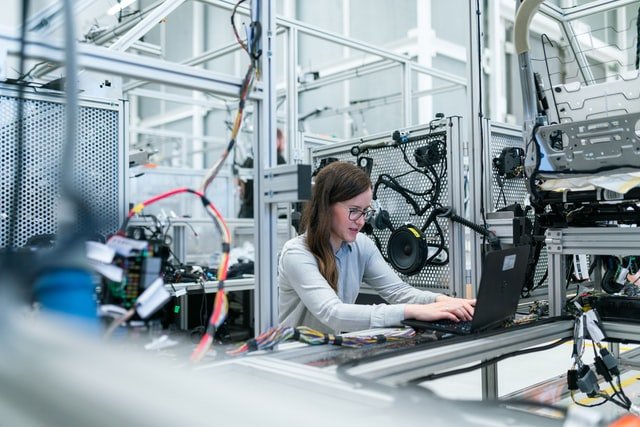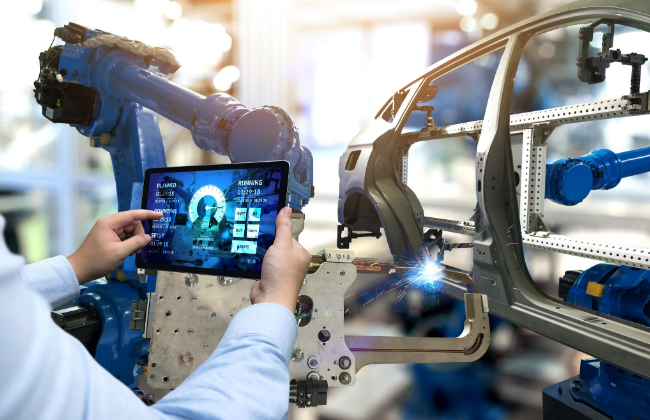By: Katie Johns
Since the start of the new millennium, no other industry has undergone the changes that digital transformation is bringing to the manufacturing industry. This change can only properly be referred to as a revolution, the Fourth Industrial Revolution! The first industrial revolution saw mass production of products such as Ford cars. In this case, the product that is being mass produced is information and data. But like every revolution, strategy is the key to victory. The battle is waging, and participation is no longer only an option! What is digital transformation and how should industry take advantage of these changes? Here is what you need to know:

Digital Transformation
Digital Transformation is the force that’s changing the world. The chip on your smartphone has more compute power than the first rocket ships that landed on the moon. Digital Transformation means switching from manual processes to autonomous processes and using data insights for business decision making. The transformational technologies that are facilitating this revolution are the cloud, big data, Artificial Intelligence(AI), Machine Learning(ML), and Internet of Things(IoT). These technologies allow for communication among the business units at every stage in the manufacturing process. Many CIOs worry their organizations are lagging behind their competitors which include new startups being founded every day.
Interesting Read- Whether or not you should outsource your Digital Transformation Projects?
The Fourth Industrial Revolution
Aristotle said “poverty is the parent of revolution”. The Fourth Industrial Revolution is no different! Impoverished manufacturing processes are causing downtimes, accidents, waste, fraud, and mistakes. Current factories cannot adjust to meet customer demands. They fail to predict new trends and streamline their supply chains.
The Fourth Industrial Revolution means customers no longer want mass produced items. Instead, your customers are demanding customized items that are produced using smart technologies. 86% of companies are in the process of Digital Transformation. The Fourth Industrial Revolution means supply chain, product development, customer service, and agile manufacturing. The key is connecting data to people and systems with the help of sensors. Employees and business processes must be tracked every second of the day. This is necessary for the factory to know what it needs to streamline processes. Anything that cannot adjust must be quickly discarded, as it will only get in the way of the smart factory from achieving this fourth revolutionary change.
The revolution can only begin with a personal revolution inside your organization. The object of the revolution is to streamline and your organization must be interested in streamlining as an end in itself. Companies must be ready to thrive in a world where overhead costs, operating costs, and capital costs are orders of magnitude cheaper. A world where the timescales of production are orders of magnitude faster.
Read how can employees be prepared for the fourth industrial revolution.

Source: InterestingEngineering
Smart Manufacturing
Smart Manufacturing is the incorporation of data analytics, machine learning, IoT, big data, and AI into the manufacturing process. The goal of smart manufacturing is to streamline the manufacturing process, to predict errors before they arise, and to meet customer demands in unprecedented ways. Employees are using this technology to develop quicker product cycles, offer customized products, gain a better understanding of their market, and improve their supply chain. Machine learning can analyze trends in purchasing and find weak spots in the supply chain before they cause issues.

The smart factory of today has data analytics, incorporating CRM, ERP, and cloud computing. Predictive analytics improve the safety of employees while decreasing costs. These analytics allow for sensors to warn factories before they break. These smart sensors create agile processes that shorten downtime. Before the advent of IoT, these devices would be too bulky and costly to end up on a factory floor. After the IoT revolution, these are essentials for a serious manufacturing process.
This factory is customer centric. New products are developed and planned based on analytics found in purchasing and search trends. An outmoded style can be replaced and repurposed within a shipping period. The brands can swap logos or designs to match trends in the news or on social media. More responsive choices can be made by using this data to automatically predict trends. Demand predictions can sort the optimal speed of production, quickening product if data predicts customer demand to change rapidly. These sorting algorithms can choose where the product should be manufactured, how many people should be hired to manufacture it, whether to ship the product or fly it, what other suppliers are doing, and when demand will change. This is information no supply chain expert could ever figure out on their own. The only way it works is by engineering processes that make optimal use of data at all times.
Now is the most important stage in the data creating process. IoT means millions of devices are set to go online for the first time this year. Top companies already have plans to maximize the data insights being generated by IoT products before they reach market. This requires knowledgeable engineers with a keen eye for industry trends. This sort of innovation is impossible with the overpriced and undeserving technology teams in most CIO offices. A committed outside group of experts is often the only way to find this level of specialization.
How to Seize the Moment
The top reason digital companies lose customers is the “failure to communicate competitive value differentiation”. [1] This means that despite organizations best efforts customers fall short in understanding the offering available to them. Sales and marketing teams that don’t adjust to digital models at speeds necessary in today’s economy. Employees must have access to the information generated by their smart technologies to make decisions that will drive growth and maintain market competitiveness.
Companies need to be ready to offer customizable solutions and hyper specialized products. If they don’t have these options, the global growth of the internet will ensure that their customers look elsewhere. Information is your factory’s biggest asset. AI works best when big data can find solutions humans wouldn’t be able to see. The AI advantage means using machine learning to find needle-in-the-haystack insights in your data and using it to improve your smart factory operations. Remote outsourcing can provide backup to your smart factory if the original supply chain works. Cybersecurity experts can monitor your factory’s cloud at all times to prevent hacking and disruptions. A cybersecurity attack on a smart factory could cause millions in damages and months in delays. The distality of the factory increases the risks to computer systems. Bad actors are looking to exploit smart factories with weak cybersecurity protocols or badly designed software.
How to choose the right team
These insights can predict safety, customer desires, machine output, or connections in supply chains millions of times better than any human could. The software engineer team you use will make all the difference. They will be your company’s most important human resource. The expertise of one AI engineer can replace hundreds of workaday product managers. You need a team that is honest, reliable, fair, and a leader in their field. Employees might resist because they fear being automated but they are wrong. Automation is not the threat, it is the competition. Your speed at automation will determine whether your company survives at all. Within the next 5 years, almost no decisions will be made solely by human employees without first consulting the AI for advice. Thinking for yourself is the hallmark of the beginning of every revolution but coherence with the data and analytics must eventually be achieved. 65% of all jobs will be replaced by AI in the next 10 years. Now is the time to position your team to thrive in this new economy.
Big data is the key to a great automation process and data harvesting must start as soon as possible. The smart factories of the future will have no need for human error, only clean data and great software. We must be ready to bring what they need.
Your organization will need to define your manufacturing objectives and set a clear strategy for innovation. You must be ready to move data and applications into the cloud. You need to partner with teams of innovators and experts in the space of digital transformation. Finally, achieving decision buy-in from all stakeholders will be necessary for the complexity of this operation.
ISHIR is the global leader in bringing digital transformation into your manufacturing processes, connect with us today!




I would like to thank you for the efforts you have made in writing this article. I am hoping the same best work from you in the future as well. In fact your creative writing abilities has inspired me.
This blog is informative and more helps me to know about how digital transformation services.
this is a very valuable thing shared, thanks to the writer.